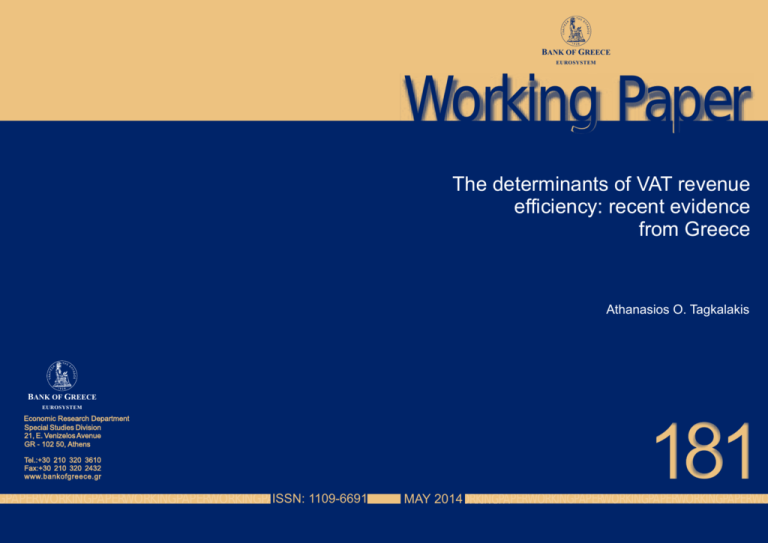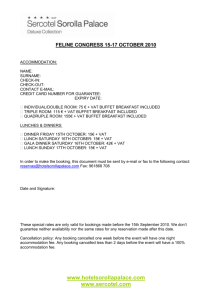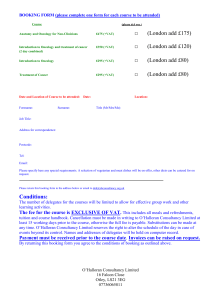
BANK OF GREECE
EUROSYSTEM
Working Paper
The determinants of VAT revenue
efficiency: recent evidence
from Greece
Athanasios O. Tagkalakis
BANK OF GREECE
EUROSYSTEM
Economic Research Department
Special Studies Division
21, E. Venizelos Avenue
GR - 102 50, Athens
Tel.:+30 210 320 3610
Fax:+30 210 320 2432
www.bankofgreece.gr
ISSN: 1109-6691
GPAPERWORKINGPAPERWORKINGPAPERWORKINGPAPER
181
MAY 2014
WORKINGPAPERWORKINGPAPERWORKINGPAPERWORKINGPAPERWO
BANK OF GREECE
Economic Analysis and Research Department – Special Studies Division
21, Ε. Venizelos Avenue
GR-102 50 Athens
Τel:
+30210-320 3610
Fax:
+30210-320 2432
www.bankofgreece.gr
Printed in Athens, Greece
at the Bank of Greece Printing Works.
All rights reserved. Reproduction for educational and
non-commercial purposes is permitted provided that the source is acknowledged.
ISSN 1109-6691
THE DETERMINANTS OF VAT REVENUE EFFICIENCY:
RECENT EVIDENCE FROM GREECE
Athanasios O. Tagkalakis
Bank of Greece
Abstract
This paper examines the relationship between VAT revenue and economic activity in
Greece by estimating the relationship between tax revenue efficiency and real GDP
growth rate. We find a positive and significant relationship between these variables, and
show that the responsiveness of tax revenue efficiency to economic activity fluctuations
has increased in the recent years. Tax efficiency is affected by changes in the ability to
curb tax evasion.
JEL classification: C32; E32; H20; O52
Keywords: VAT; GDP; tax evasion; Greece.
Acknowledgements: I would like to thank Jim Alm, Heather Gibson, George
Hondroyiannis, Dimitris Malliaropulos and Basil Manesiotis for their very helpful
comments. The views of the paper are my own and do not necessarily reflect those of the
Bank of Greece. All remaining errors are mine.
Correspondence:
Athanasios O. Tagkalakis
Economic Research Department, Bank of Greece,
21 El. Venizelos Av. 10250 Athens, Greece
Email: atagkalakis@bankofgreece.gr
Tel.:0030-210-3202442
Fax: 0030-210-3232025
1.
Introduction
The success of the on-going fiscal consolidation effort is one of the prerequisites
for the recovery of the Greek economy. This implies that all possible interactions
between fiscal consolidation and economic activity have to be fully understood.
However, an issue that has not yet received appropriate attention relates to the fact
that since the start of the implementation of the Economic Adjustment Programme (EAP)
for Greece in May 2010 there have been recurrent revenue shortfalls, in particular as
regards VAT and indirect tax revenue in general. Successive increases in VAT rates and
excise taxes since the start of the EAP did not bring about a higher VAT and indirect tax
ratio to GDP (IMF, 2012; 2013). This could be related to behavioral changes by
consumers (a shift in demand towards low VAT (necessity) goods), as well as a
worsening in tax compliance (IMF, 2013) which is particularly relevant during recessions
(see e.g. Poghosyan 2011; Brondolo 2009; Sansac et al. 2010). All in all these
developments contributed to a deteriorating VAT revenue collection efficiency in recent
years (see Figure 1).
Building on the aforementioned studies we examine the VAT revenue performance
as a way of understanding the recent revenue shortfalls. We estimate the relationship
between VAT revenue efficiency and real GDP growth rate. While doing that we control
for the ability to curb tax evasion, as well as shifts in consumption patterns towards
necessity goods.
Our findings show that an improvement (deterioration) in economic conditions
increases (reduces) VAT efficiency. A 1 percent increase in the rate of growth of real
GDP raises VAT efficiency by about 0.63 p.p. We find evidence that VAT efficiency
tends to be lower on average when economic conditions are bad. According to our
findings VAT efficiency has become more responsive to economic activity developments
since the start of 2009 (when the economic crisis deepened).
Additionally, we show the deterioration in the ability to fight tax evasion (that
usually takes place in economic downturns) reduces VAT efficiency. Shifts towards
necessity goods (that are usually taxed at a lower VAT rate) are associated negatively
5
with VAT efficiency, thought the results are not statistically significant. Building on
Sansac et al. (2010), we show that the increase in tax evasion is a significant and relevant
channel through which the real GDP growth rate impacts on VAT efficiency.
The key implication of our analysis is that policy makers should take into account
in their forecasts that revenue performance varies significantly through the cycle. This
requires strengthening the tax enforcement mechanism to combat tax evasion, as well as
recognizing that further increasing tax obligations will not necessarily translate into
increased revenue in recession periods that both individuals and firms face binding
financing and liquidity pressures.
In the remainder we consider the following: Section 2 discusses data issues,
methodology and discusses issues related to VAT collection efficiency. Section 3
summarizes and concludes.
Figure 1: VAT collections and efficiency
55%
25.0%
50%
20.0%
45%
40%
VAT-C-Efficiency (LHS)
15.0%
Top VAT rate
35%
VAT/Y
10.0%
30%
5.0%
25%
20%
0.0%
Notes: Top VAT rate is standard VAT rate; VAT/Y is VAT collections as a % of GDP.We define VAT –CEfficiency as the share of VAT revenues in the private consumption, normalized by the standard tax rate: VAT revenue
efficiency ratio = (VAT revenue/private consumption)/standard tax rate*100.
6
2.
Data, methodology and findings
We use quarterly data on VAT revenue, private consumption and GDP over the
period 2000:Q1-2012:Q3. Data are transformed in real terms by means of the GDP
deflator.1 Following earlier IMF studies, like Sansac et al. (2010), we investigate the
effect of cyclical economic activity developments on VAT revenue efficiency. 2 Using
data over the period 2000:Q1 – 2012:Q3 we regress by means of OLS (with robust
standard errors) equation (1)3:
VAT C-efficiencyt = α + β*Δlog(Real GDP)t +Electionst + EAPt + EDPt+ time
trendt + EAP* time trendt + εt
(1)
The economic activity variable used is: Δlog(Real GDP)t =log Real GDP t-log Real
GDP
4
t-4.
The “election” dummy captures election periods; there is anecdotal evidence
that revenue collection and budgetary performance deteriorates in election periods. 5 The
EDP dummy variable captures the period that Greece was in excessive deficit procedure,
i.e. 2004:Q3-2007:Q2 and from 2009: Q1 -2010:Q1; controlling for (tax) policy changes
that occurred in that period.
Greece continues to be in EDP in the post 2010:Q2 period, however, we
differentiate between the pre- and post-EAP era because in the period that Greece
receives EU-IMF funding (from 2010:Q2 onwards) surveillance procedures are stricter
and much more intense relative to the pre-EAP EDP surveillance. Hence, the “EAP”
1
Data are seasonally adjusted by means of the census X12 procedure.
We define VAT (indirect tax) revenue efficiency as the share of VAT (indirect tax) revenues in the tax
base (private consumption), normalized by the standard tax rate, e.g. in case of VAT: VAT revenue
efficiency ratio = (VAT revenue/private consumption)/standard tax rate*100. This is called VAT
Consumption (C) efficiency. Data on VAT rates were taken from Bank of Greece (2009-2013).
3
We have also considered OLS with Newey-West standard errors, i.e., the error structure is assumed to be
heteroskedastic and autocorrelated up to lag one. Moreover, we have also considered a generalized leastsquares method to estimate the parameters in a linear regression model in which the errors are assumed to
follow a first-order autoregressive process.
4
Due to data availability issues we consider real GDP growth and not the output gap (as in Sancak et al
(2010)) as our cyclical economic activity variable. There is no quarterly output gap indicator based on the
production function approach, therefore we would have had to rely on a purely statistical procedure, such as
the HP filter, to extract the cyclical component of real GDP. Instead of doing that we preferred relying on
real GDP growth rate as our cyclical economic activity variable.
5
The election dummy takes value 1 in the quarters that national elections were held (2002 Q2, 2004 Q1,
2007 Q3, and 2009 Q4, 2012 Q2) and zero otherwise.
2
7
dummy captures the period that Greece is under joint EU-IMF surveillance (since May
2010); during that period Greece had to take several measures to improve revenue
administration and to fight tax evasion. Moreover, tougher consolidation measures were
implemented in this period. The time trend captures time related effects that affect the
relationship between VAT and GDP. The interaction term “EAP*time trend” captures
trend related effects in the EAP era.
Alternatively, and building on specification (1) we investigate the behavior of VAT
efficiency in bad and good economic times. In bad economic times the real GDP growth
rate takes negative values, while in good economic times takes positive values. The
findings are reported in Table 1.
As shown in column 1 in Table 1 a 1 percent increase in real GDP growth improves
VAT efficiency by about 0.63 p.p. Turning to the behavior of VAT efficiency in bad and
good economic times we find evidence that there is positive (and in most cases)
significant relationship between revenue efficiency and the real GDP growth rate in both
bad and good economic times (see columns 2, 3 and 4 in Table 1). However, as shown by
the coefficient of the bad time variable in column 5 (in Table 1) VAT efficiency tends to
be lower on average when the economy is in recession, as the estimated bad times
variable coefficient is negative and significant. Nevertheless, in terms of the slope, there
is no significant difference between good and bad times, as the coefficient of the bad time
dummy interacted with the real GDP growth rate is not particularly significant (in Table
1).
8
Table 1: VAT-C-efficiency in good and bad times
Growth rate
of real GDP
Bad times
1
Full sample
0.629
(3.01)***
-
Good times
-
Bad times*
Growth rate
of real GDP
Elections
-
2
Full sample
1.039
(2.51)**
0.358
(1.96)*
-
3
Good times
0.099
(0.51)
-
4
Bad times
0.553
(1.84)*
-
-
-
-
-
-0.004
(-0.54)
0.783
(2.97)***
-0.021
(-2.68)***
-0.0003
(-0.82)
-0.004
(-3.10)***
0.575
(7.87)***
0.845
47
F( 6, 40) :
62.53
(0.000)
-
-0.003
-0.012
0.005
(-0.45)
(-1.25)
(0.60)
EAP
0.689
2.008
(2.23)**
(0.96)
EDP
-0.017
-0.021
-0.060
(-2.36)**
(-2.47)**
(-1.00)
Time trend
-0.0005
0.0001
0.006
(-1.43)
(0.37)
(0.53)
EAP*time
-0.003
-0.010
trend
(-2.20)**
(-0.95)
constant
0.624
0.515
-0.563
(8.81)***
(6.90)***
(-0.28)
R-sq
0.857
0.251
0.755
No. of obs.
47
29
18
F-test
(pF( 7, 39) : F( 4, 24) : F( 6, 11) :
value)
54.15
1.90
16.79
(0.000)
(0.1438)
(0.0001)
F-test:
F( 1, 39) Bad=Good
: 2.42
(p-value)
(0.1279)
Notes: OLS estimation, robust standard errors in parenthesis; ***, **, *statistically
and 10%, respectively.
5
Interactions
0.105
(0.56)
-0.038
(-3.74)***
0.671
(1.65)
-0.005
(-0.68)
0.857
(3.02)***
-0.022
(-3.24)***
0.0002
(0.45)
0.511
(7.11)***
0.878
47
F( 8, 38) :
59.03
(0.0000)
-
significant at 1%, 5%
Last but not least, in Figure 2 and we report evidence that VAT efficiency has
become more responsive to economic activity developments since the start of 2009 (when
the contraction in economic activity became more pronounced). 6
6
This evidence is based on the recursive estimation of specification (2) that incorporates additional control
variables. There is a "spike" in the efficiency figures in 2009 Q1. This is linked to the collapse of the tax
collecting mechanism, which is related to changes in tax-revenue administration and Ministry of Finance
officials in 2009 Q1. However, it should be recalled that since 2009 Q1 Greece has been in EDP procedure
in view of the deterioration of public finances.
9
Figure 2: The effect of economic activity on VAT-C-efficiency
1.20
1.00
0.80
0.60
0.40
0.20
-0.20
2008q1
2008q2
2008q3
2008q4
2009q1
2009q2
2009q3
2009q4
2010q1
2010q2
2010q3
2010q4
2011q1
2011q2
2011q3
2011q4
2012q1
2012q2
2012q3
0.00
-0.40
The effect of economic activity on VAT-C-efficiency
95% confidence interval
95% confidence interval
2.1.
Shifts in consumption patterns and tax evasion
Building on the work of Sansac et al. (2010) we now investigate the effect of
possible shifts in consumption patterns, as well as the effect of the ability to control tax
evasion.
As pointed out by Sancac et al (2010) “during a downturn (upswing), it is
reasonable for rational consumers to increase (decrease) the share of necessity goods
and services in total consumption.” In addition as pointed out by Sancac et al (2010)
“shifts in consumption patterns can have a significant impact on revenue collections, as
necessity items are either zero-rated or taxed at a lower than standard rate in many
countries.” Figure 3 shows that there is a negative correlation between the share of food
and non-alcoholic beverages in total household consumption and real GDP growth. In
addition, there is a significant negative correlation between real GDP growth and the
share of housing, water, electricity, gas and other fuels in total household consumption.7
7
The correlation between real GDP and food and non-alcoholic beverages is -0.27, whereas that between
real GDP and housing, water, electricity, gas and other fuels is -0.60. Data on consumption shares are
10
Figure 3: The share of food and non-alcoholic beverages and housing, water, electricity, gas and
other fuels in total household consumption expenditure vis-à-vis the real GDP growth rate
As reported by Poghosyan (2011), Brondolo (2009), Sansac et al. (2010) firms and
households are more likely to evade taxes in bad economic times, i.e., when they are
credit constrained and face financial pressures. Following Sansac et al. (2010) and given
the absence of hard data on tax evasion, we rely on a qualitative indicator provided by the
IMD’s World Competitiveness Online database. This indicator is based on IMD’s
company executives’ surveys, ranking tax evasion issues on a scale from 0 to 10 (with
higher values imply improved ability to control tax evasion). As shown in Figure 4,
declining economic activity goes hand-in-hand with a deterioration in the ability to fight
tax evasion (i.e. an increase in (the perceived) tax evasion).8 Based on this evidence we
expect that an increase in the ability to control tax evasion will translate into an increase
in VAT revenue efficiency.
taken from Eurostat. See Eurostat, Statistics in focus, 2/2013, Analysis of EU-27 household final
consumption expenditure.
8
Real GDP growth and the ability to control tax evasion have a significant positive correlation of 0.88.
11
Figure 4: Ability to control tax evasion vis-à-vis real GDP growth rate
Using data over the period 2000:Q1 – 2012:Q3 we regress by means of OLS (with
robust standard errors) specification (2) in order to study the effect of the shift in
consumption patterns and the ability to control tax evasion on VAT C-efficiency9:
VAT C-efficiencyt = α + β*Δlog(Real GDP)t + Shift in consumption patternst
+Control of Tax Evasiont +Electionst + EAPt + EDPt+ time trendt + EAP* time trendt +
εt
(2)
According to the evidence presented in Table 2, the shift in consumption patterns
towards necessity goods exerts a negative but insignificant effect on VAT C-efficiency
(see columns 1-2).
9
We have also considered OLS with Newey-West standard errors, i.e., the error structure is assumed to be
heteroskedastic and autocorrelated up to lag one. Moreover, we have also considered a generalized leastsquares method to estimate the parameters in a linear regression model in which the errors are assumed to
follow a first-order autoregressive process. Both the tax evasion measures and the share of necessity goods
in consumption are available in annual frequency and have been transformed by the authors to quarterly
frequency.
12
Table 2: VAT-C-efficiency, share of necessity goods and control of tax evasion
Growth rate of
real GDP
Consumption
share of food
and non
alcoholic
beverages
Consumption
share of food
and housing,
water,
electricity, gas
and other fuels
Control of tax
evasion
Elections
EAP
EDP
Time trend
EAP*time
trend
constant
R-sq
No. of obs.
F-test (pvalue)
1
0.621
(2.90)***
-0.136
(-0.37)
2
0.617
(2.94)***
-
3
0.571
(2.73)***
-
4
0.537
(2.54)***
-0.650
(-1.43)
5
0.510
(2.53)**
-
-
-0.043
(-0.12)
-
-
-0.521
(-1.09)
-
-
-0.005
(-0.58)
1.383
(2.76)***
-0.021
(-2.55)**
-0.0002
(-0.43)
-0.007
(-2.79)***
0.584
(8.25)***
0.818
-0.005
(-0.62)
1.368
2.22)**
-0.0216
(-2.64)**
-0.0002
(-0.19)
-0.007
(-2.24)**
0.575
(7.08)***
0.818
0.011
(1.89)*
-0.006
(-0.74)
0.781
(2.73)***
-0.025
(-3.17)***
-0.0004
(-0.92)
-0.004
(-2.81)***
0.555
(7.46)***
0.852
0.017
(1.99)*
-0.008
(-0.89)
1.758
(3.23)***
-0.025
(-3.15)***
0.00008
(0.14)
-0.009
(-3.26)***
0.579
(8.38)***
0.834
0.016
(2.06)**
-0.009
(-1.03)
2.018
(2.74)***
-0.027
(-3.33)***
0.0009
(0.69)
-0.010
(-2.77)***
0.521
(5.75)***
0.832
44
F( 7, 36)
:
63.60
(0.000)
44
F( 7, 36)
:
61.28
(0.000)
47
F( 7, 39)
: 55.99
(0.000)
44
F( 8, 35)
:
53.25
(0.0000)
44
F( 8, 35)
: 50.76
(0.000)
Notes: OLS estimation, robust standard errors in parenthesis; ***, **, *statistically significant at 1%, 5%
and 10%, respectively.
Adding the variable for the control of tax evasion reveals that an increase in the
ability to control tax evasion improves VAT revenue efficiency (see column 3, Table 2).
The fact that the coefficient on real GDP growth declines (compared to that in Table 1column 1 where we do not control for tax evasion) implies that tax evasion is a relevant
channel through which the real GDP growth rate has an impact on VAT revenue
efficiency (see Sansac et al., 2010).
13
Incorporating both the shift in consumption patterns and the tax evasion proxy
reduces substantially the coefficient estimate of real GDP growth, however it remains
statistically significant.. Specifically, in Table 2- columns 4-5 it declines to 0.510-0.537
from 0.629 in Table 1-column 1 where neither of the control variables under discussion is
included. This indicates, as pointed out by Sansac et al. (2010), that the increase in tax
evasion and to a much lesser extent the shift in consumption patterns are relevant
channels through which the real GDP growth rate impacts on VAT tax efficiency.10
3.
Summary and conclusions
The above analysis provides empirical evidence that the VAT revenue efficiency is
positively associated with economic activity. A 1 percent increase in real GDP growth
improves VAT efficiency by about 0.63 p.p. We find evidence that in contractions
revenue efficiency declines compared to periods of expansion. In addition, VAT
efficiency has become more responsive to economic activity developments since the start
of 2009 when the contraction of the Greek economy accelerated.
Building on the work of Sansac et al. (2010) we then investigated the effect of
possible shifts in consumption patterns towards necessity goods, as well as the effect of
the ability to control tax evasion. Both the shift in consumption patterns towards
necessity goods and reduced tax compliance are more likely to occur in periods of
economic decline and financial stress. Our estimates reveal it is primarily the control of
tax evasion that impacts on tax efficiency. There is limited but not significant evidence
that the shift towards necessity goods (that are usually taxed at a lower VAT rate) has
reduced VAT efficiency.
At the same time we find that when incorporating both the shift in consumption
patterns and the tax evasion proxy in our specifications, the coefficient estimate of real
10
Turning to the other control variables we see that under the EDP, VAT efficiency deteriorated, while
VAT efficiency improved with the measures adopted in the period under joint EU-IMF surveillance (EAP
dummy). This could be also explained by the recent evidence that the intensification of tax audits in 2012
reduced VAT tax offenders (Tagkalakis, 2013). The interaction term between the time trend and the EAP
dummy reveals a trend deterioration in VAT efficiency in more recent years. The elections dummy has a
negative but insignificant effect on efficiency.
14
GDP growth declines by up to 19-21% but it remains statistically significant. This
indicates, as pointed out by Sansac et al. (2010), the increase in tax evasion is a
significant and relevant channels through which the real GDP growth rate impacts on
VAT efficiency. As pointed above the evidence is weak and not significant as regards the
shift toward necessity goods.
The most important implication of the analysis is that policy makers should take
into account the effects of the economic cycle on revenue performance. VAT efficiency
shows increased responsiveness to economic activity changes in particular in recent
years. Part of this could possibly be explained by increased incentives to tax evade (there
is no significant evidence regarding the shift in consumption patterns towards necessity
goods taxed with lower VAT rates). This requires strengthening the tax enforcement
mechanism to combat tax evasion. At the same time further increasing tax obligations
will not necessarily translate into increased revenue in recession periods that both
individuals and firms face binding financing and liquidity pressures.
15
References
Bank of Greece (2009) “Governor’s Annual Report for 2008”. Annex to Chapter
VIII: Tax policy changes April, Bank of Greece.
Bank of Greece (2010) “ Governor’s Annual Report for 2008”. Annex to Chapter
VIII: Tax policy changes, April, Bank of Greece.
Bank of Greece (2011) “Governor’s Annual Report for 2010”. Annex to Chapter
IX: Tax policy changes, April, Bank of Greece.
Bank of Greece (2012) “Governor’s Annual Report for 2011”. Annex to Chapter
IX: Tax policy changes, April, Bank of Greece.
Bank of Greece (2013) “Governor’s Annual Report for 2012”. Annex to Chapter
IX: Tax policy changes, February, Bank of Greece.
Brondolo, J., (2009). Collecting Taxes During an Economic Crisis: Challenges and
Policy Options, IMF Staff Position Note 09/17 (Washington: International Monetary
Fund).
IMF, (2012). Greece: Request for Extended Arrangement Under the Extended Fund
Facility, IMF Country Report No. 12/57.
IMF, (2013). Greece: Third Review Under the Extended Arrangement Under the
Extended Fund Facility, IMF Country Report No. 13/20.
Poghosyan T., (2011). Assessing the variability of tax elasticities in Lithuania, IMF
WP 11/270.
Sancak, C., Velloso, R., and Xing, J., (2010). Tax Revenue Response to the
Business Cycle, IMF Working Paper 10/71 (Washington: International Monetary Fund).
Tagkalakis, A., (2013). Audits and tax offenders: recent evidence from Greece.
Economic Letters, 118(3), pp.519-522.
16
BANK OF GREECE WORKING PAPERS
171.
Tagkalakis, O. A., “Assessing the Variability of Indirect Tax Elasticity in
Greece”, January 2014.
172.
Koukouritakis, M., A.P. Papadopoulos and A.Yannopoulos, “Transmission
Effects In The Presence of Structural Breaks: Evidence from South-Eastern
European Countries”, January 2014.
173.
Du Caju, P., T. Kosma, M. Lawless, J. Messina, T. Rõõm, Why Firms Avoid
Cutting Wages: Survey Evidence From European Firms”, January 2014.
174.
Mitrakos, T., “Inequality, Poverty and Social Welfare in Greece: Distributional
Effects of Austerity”, February 2014.
175.
Lazaretou, S., “Η Έξυπνη Οικονομία: «Πολιτιστικές» και «Δημιουργικές»
Βιομηχανίες Στην Ελλάδα Μπορούν Να Αποτελέσουν Προοπτική Εξόδου Από
Την Κρίση”, February 2014.
176.
Chouliarakis, G., and S. Lazaretou, “Déjà Vu? The Greek Crisis Experience, the
2010s Versus the 1930s. Lessons From History”, February 2014.
177.
Tavlas, G.S., “In Old Chicago: Simons, Friedman and The Development of
Monetary-Policy Rules”, March 2014.
178.
Bardakas, C. I., “Financing Exports of Goods: a Constraint on Greek Economic
Growth, March 2014.
179.
Tagkalakis, O., “Financial Stability Indicators and Public Debt Developments”,
May 2014.
180.
Kaplanoglou, G., V. T., Rapanos , and I.C, Bardakas, “Does Fairness Matter for
the Success of Fiscal Consolidation?”, May 2014.
17







